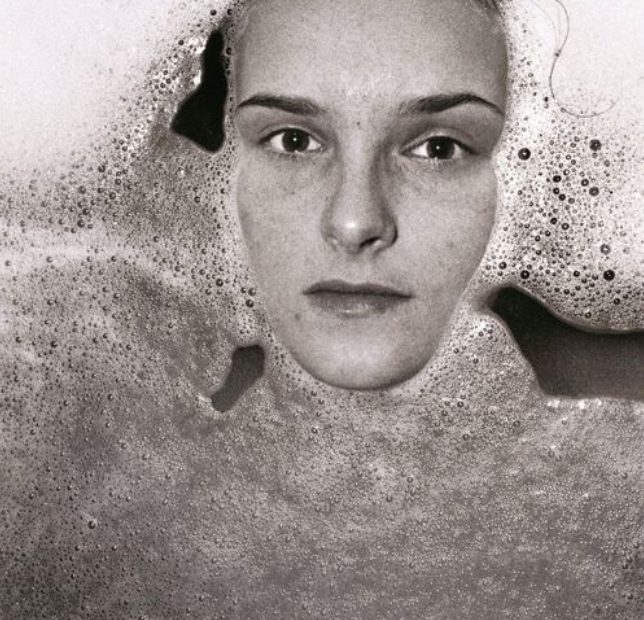By Sophia Namara, Manager of PhoPa Gallery, Portland, ME, affiliated with Maine Media Workshops + College.
In a simple, yet striking portrait, Seiichi Furuya pays tribute to the phrase, “there is always more to someone than meets the eye.” Through both visual metaphor and compositional structure, the photo titled Graz muses on the idea that a person’s beauty may conceal what they are feeling or thinking. Humans are, after all, a sum of paradoxes, who have flaws contained within beauty, and who do not always share on their face what may be lingering beneath the surface.
I first saw this portrait at SFMOMA and was immediately drawn to it. We see a woman’s face staring directly into the camera, her body obscured by bath water. Her expression is calm and yet her slightly raised eyebrow suggests something is being hidden. Perhaps, a joke is being shared between her and the photographer?
Whether intentional or not, the water becomes a blurred surface, shades of grey and white that allow the viewer to focus solely on the intricacies of this woman’s expression. Indeed, the subject’s close proximity to the lens, the implied bathroom setting, and her direct eye contact make us wonder what could have created the context for such an image. It is an incredibly intimate portrait.
Further research[1][2] reveals that Graz is a photograph of the artist’s wife. Christine Gössler met Furuya in 1978. She lived in Austria with her husband, and in 1985, she committed suicide. This portrait was taken only a few years before her death and the knowledge of that event casts a melancholy shadow over the beauty of the image. Looking again at the portrait, is there a veil of sadness over her eyes? Is she emerging or retreating? What is lingering beneath the surface of that gaze?
The photo becomes that much more rich as Furuya sets up the visual metaphor of a face emerging from the surface of water, while the rest of the body is obscured. Initially, we bear witness to an intimate moment between husband and wife, but ultimately we are seeing a woman whose story would soon change dramatically.
Much of Furuya’s work revolves around his wife. There is a curiosity, care, and respect for her that permeates his practice. In a descriptive piece on the photographer, the Metropolitan Museum writes, “Like a writer mulling over his material, Furuya coaxes clues out of the unanswerable questions of human suffering and experience.”
Naturally, Furuya uses his talent and skill as a photographer to make sense of his marriage and his wife’s condition. In his oeuvre, he pays tribute to Christine’s life and her beauty. In the end, his portrait, and all portraiture, is a tool for understanding humanity. Our flaws, our beauty, and our individuality all contained within a figure or expression frozen in time.
While not incredibly well known, Seiichi Furuya’s work is a worthy addition to the canon of photographic portraits taken in the 20th century.
[1] “Seiichi Furuya, Izu.” The Metropolitan Museum of Art. Accessed April 18, 2018.
[2] “Seiichi Furuya.” Galerie Thomas Fischer. Accessed April 18, 2018.

